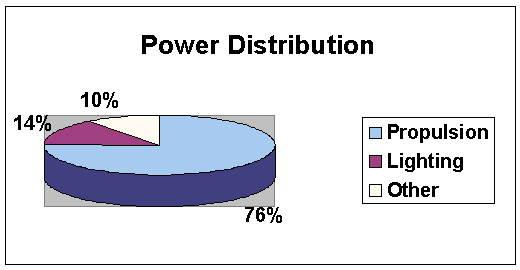 |
 |
 |
 |
 |
 |
 |
 |
 |
 |
 |
 |
 |
Powering the Submersibles
Energy is by far the most important limitation that faces designers of deep sea submersible. Most submersibles today use high-energy density batteries. These are divided into secondary batteries, primary batteries and fuel cells.
Secondary batteries: They are rechargeable and examples include the lead acid battery used in cars, nickel cadmium, siver zinc, silver iron and lithium ion.
Primary batteries: They can only be used once, and examples include lithium sulphur oxide and aluminum-seawater. These batteries may sound less attractive than secondary batteries due to the lack of the recharging option, but on the other hand, they have up to four times the energy density of their secondary counterparts, which means that the submarine can stay for a longer time in water.
Fuel cells: Fuel cells have an energy density in between, can be recharged by refilling their reactant tanks with the fuel. Examples include aluminum-oxygen fuel cells, alkaline fuel cells, aluminium-water semi-cell and proton exchange membranes.
Heat engines like diesel engines are also an option.
The factors that determine the choice of a the energy source are:
1. Energy density.
2. Cost.
3. Life cycle (number of times it can be recharged).
4. Cost.
5. Maturity and reliability (has it been tested thoroughly for submersibles or is it just a lab demo?).
6. Safety concerns (such as hydrogen generation, fuel fires, thermal runaway, toxicity of chemicals used).
7. Power density (ability to supply the power needed at the necessary rate).
8. Ability to operate over a wide range of temperatures and pressures.
9. Environmental friendliness.
After a careful comparison of 26 energy sources and the application of each of the above criteria to it, we have decided to use aluminum-oxygen fuel cells. Before delving into the reasons for how this fuel cell works and why we chose it, let us consider how much energy we shall need for each trip we make.
Our submersible uses power for the following things:
Propulsion
Energy for propulsion can be calculated as follows: Energy = Power x Time of operation x Efficiency The power of a propeller is usually measured in horsepower. The effective horsepower of a propeller is given by: EHP = Total resistance (drag) x Velocity / 550 The total resistance is the sum of the bare hull resistance and the resistance due to the appendages. The calculation of the resistance is not easy at all. Actually, it can only be roughly estimated using potential-flow computer models. So does doubling the power double the submersible's velocity? No! The relation between velocity and EHP is not linear as you may think when you first look at the above formula. Remember that the resistance is also a function of the velocity (in fact it varies as the square of the velocity. Refer to the hull design page for more information about calculating the resistance.) Thus, it is very hard for research submersibles to achieve high speeds. For example, the maximum speed the Alvin can achieve is 2 knots (3.7 km/hr.) We aim at a higher speed of about 3 knots (5.6 km/hr.) Therefore, our submersible should be much more streamlined and should have propellers that can provide much more power. Going at higher speeds is almost impossible because as mentioned, the power needed is proportional to the cube of the velocity. That explains why cars can easily go up to 150 km/hr, but jumping to 200 km/hr requires very good design and a very powerful motor. Moreover, we shall have to use several thrusters. We shall use 4 thrusters for forward and backward motion, 2 for vertical motion and 1 as a rudder. No more than 5 thrusters shall be used together at the same time (this being controlled by computer systems on board.) We shall use 10hp electrical thrusters. Therefore, a maximum of 37.3kW shall be used for propulsion (1hp = 746W) at any time.
Lighting
We shall have four floodlights outside the submarine which need 1000W each. In addition, we shall need lighting inside the submarine. We have estimated the total power used for lighting to be around 7kW.
Other equipment
Other equipment such as computers, life support equipment and communications equipment is estimated to need a total of 5kW.
Thus, the total power we need shall be about 50kW. Our main power supply shall be an aluminum-oxygen fuel cell, which can easily meet this requirement. In fact, recent advances have made it possible for aluminum-oxygen fuel cells to supply up to 250kW!

Details of the Aluminum-Oxygen Fuel Cell
Details of Aluminum-Oxygen Fuel Cells:
Electricity is generated in this fuel cell by the oxidation of aluminum. The aluminum is dissolved in an alkaline solution and the oxygen is supplied by the decomposition of hydrogen peroxide. The reactions that generate the electricity are as follows:

This cell has many advantages. First, it can meet the high power requirements of our submersible. Also, it recharges in seconds, since the recharge process is a mechanical one where depleted chemicals are replaced. For the sake of convenient recharging, the cell shall have to be placed inside the pressure hull. Another advantage is the high energy density of the fuel. It has a gravimetric energy density of 450 watt-hours/kg and a volumetric energy density of 700watt-hours/l.
How much fuel do we need to carry?
We have calculated our power needs to be 50kW. For an eight-hour journey during which all submarine systems are working at full power we shall need 400kW-hours of energy. This translates into about 900kg or 0.57 cubic meters of fuel for each trip!
References:
1. Undersea Vehicles and National Needs, by the National Research Council
2. Submersible Vehicle Systems Design, written by a group of authorities and edited by E. Eugene Allmendinger.
3. Aluminum Power Inc. website
4. Fuel Cell Technology Report (PDF document)
5. Fuel Cell Technologies Ltd: Aluminum Power Systems
Posted by Waseem Bakr on 11/04/2001